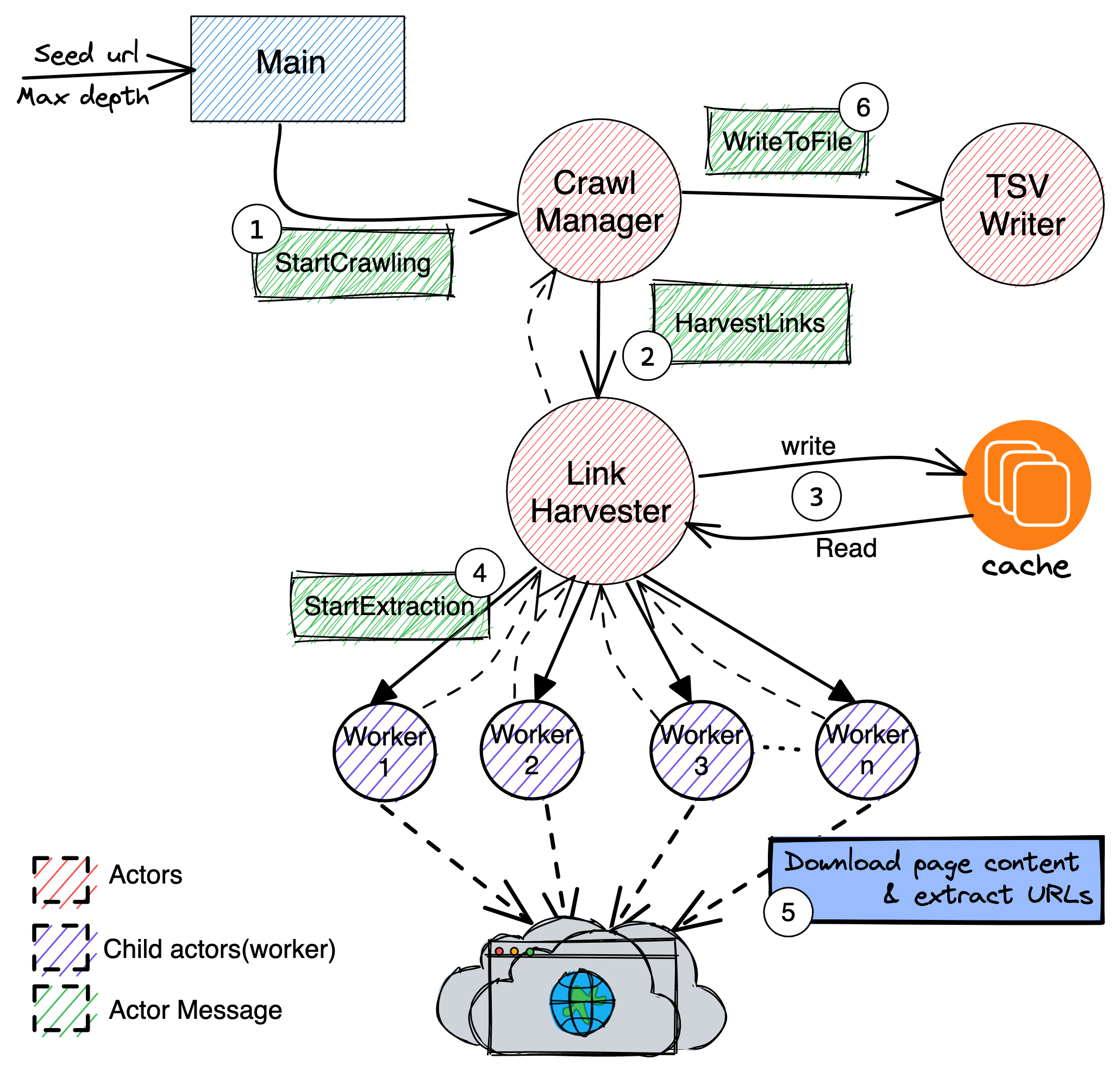A simple web crawler built using Scala and Akka Typed
- Scala
- Akka Typed
- Caffeine (In-memory cache)
Various components of this web crawler are designed using akka actors to achieve maximum concurrency in a non-blocking fashion. The result obtained after crawling each webpage is written immediately to a TSV file.
The application starts with reading two input parameters
- seed url - The URL to start crawling at
- max depth - Maximum depth until the crawler run recursively.
An actor manages the entire web crawling process.
It creates a child actor called LinkHarvester and delegate work to it.
- On receiving message
StartCrawling, it is submitted to LinkHarvester - LinkHarvester responds with
HarvestedLinkson successful URL download - LinkHarvester responds with
LinkHarvestFailedon any failures - Calculate
page rankon receiving successful response and send it toTSVWriter
This actor performs url downloads recursively by adjusting its behavior. Additionally,
this actor keeps an internal state Map[Depth, Number of requests] to keep track every requests in-flight.
This Actor coordinates url downloads and cache access.
It creates N child actors (LinkExtractionWorker) based on the number of child Urls a page has.
Each child actor will download and parse a single URL.
-
On receiving message
HarvestLinks, it checks the cache for the URL.- If an entry is found in Cache, it will return the cached value to CrawlManager
- If no entry is found in cache, it will spawn a worker and send a
StartExtractionmessage to it.
-
When a response is obtained from a worker,
- It will be written to cache
- Return crawled urls to
CrawlManager
An in-memory cache implementation backed by Caffeine It uses Window TinyLfu
See: https://github.com/ben-manes/caffeine/wiki/Efficiency
For implementing caching within this application, an interface is provided using the trait WebCrawlerCache
This way, introducing a new cache (eg: Redis) can be done without significant code changes.
Just provide an instance of your custom cache implementation at application startup.
See: Main.scala#RootBehavior.apply
These are child actors created on demand by the LinkHarvester actor.
It performs the actual work of loading a webpage and extract child urls from it.
It uses JSoup under the hood to perform URL scraping.
On successful URL download,
- it will return
LinkExtractionSuccessto LinkHarvester.
On any failure,
- it will return
LinkExtractionFailedto LinkHarvester.
These are lightweight and short-lived actors. After completing the designated work, it stops and release memory. We can utilize the maximum available CPU cores on a machine this way. The current implementation is not distributed(runs on a single machine), but we can introduce an akka cluster and distribute these actors to multiple nodes for any future scalability requirements.
This is a dedicated actor to perform write operations to a TSV file.
- It will create the output directory if not present
- The output directory path can be configured using the application configuration
- It can also be configured using an environment variable
CRAWLER_OUTPUT_DIRECTORYSee:application.conf
.
├── README.md
├── build.sbt <- sbt build definition
├── docs <- supporting readme assets
├── output <- output directory
├── project <- sbt specific settings
├── src
│ ├── main
├── resources
│ ├── application.conf <- the application configuration
│ └── logback.xml <- logging configuration
└── scala
│ └── com
│ └── robinraju
│ ├── Main.scala <- the main application entrypoint
│ ├── cache <- cache implementations
│ ├── core <- helpers for config and output result
│ ├── crawler <- akka actors
│ ├── io <- TSV file writer
│ └── util <- Pagerank calculation function
│ └── test <- unit tests
- Java 11 or greater
- SBT 1.3.x or greater - https://www.scala-sbt.org/download.html
Start a new sbt session from the project root
sbt
Run tests using the test command
sbt:web-crawler> test
Run crawler using the run command
sbt:web-crawler> run https://crawler-test.com/ 2
This will start crawling the above url until depth 2.
Check the output directory for TSV file.
For every run it creates a new
TSVfile with a filename containing system time stamp.
There is room for a lot of improvements on this crawler. Keeping the current crawling logic (just calculating pagerank), I would add the following
- Metrics to monitor performance and behavior of different actors
- Number of worker actors running
- Crawl latency
- URL fetch failure count
- Cache hit/miss ratio
- Cache size
- Application packaging for deployment
- A cli app with some command line argument parsing
- Clustering, for distributed crawling
- Akka cluster allows us to start crawler on different nodes/machines and join the existing cluster
- More test coverage

